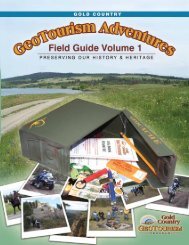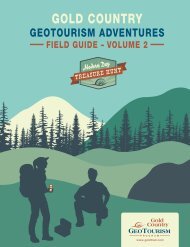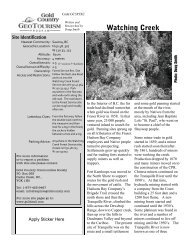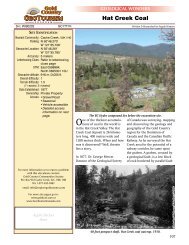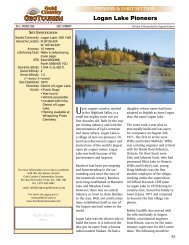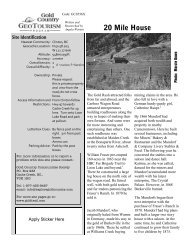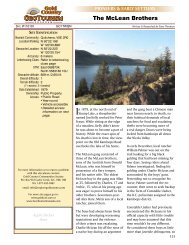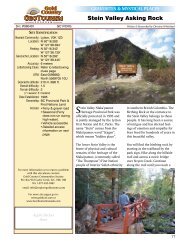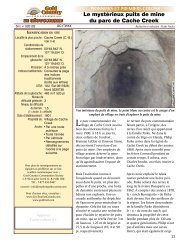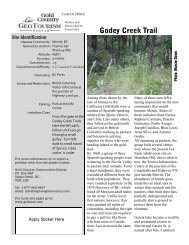E book Field Guide.indd - Gold Country
E book Field Guide.indd - Gold Country
E book Field Guide.indd - Gold Country
Create successful ePaper yourself
Turn your PDF publications into a flip-book with our unique Google optimized e-Paper software.
to Savona and over time Leighton took up ranching,<br />
acquiring 1,800 acres, with another 2,400 acres leased.<br />
He took on the task of running the ferry at Savona, was<br />
district cattle overseer, Fisheries Officer and superintendent<br />
of the B.C. Express. In James’ retirement he<br />
published some of his reminiscences in ‘The Sentinel’<br />
newspaper in Kamloops. He passed away in 1945 at the<br />
age of 94.<br />
Tunkwa and Leighton Lakes were made larger by damming<br />
the outlets. Downstream grazing lands benefit<br />
from a summer supply of water from these reservoirs.<br />
This occurred as early as 1909 when James Leighton<br />
funded a project to use the headwaters of Guichon<br />
Creek. By putting a ditch into Tunkwa Lake and another<br />
at Leighton Lake, with dams on both to feed Durand<br />
Creek as needed, he was able to provide irrigation and<br />
domestic water for the ranches on the southern hills<br />
above Savona.<br />
James Leighton came from Scotland to California in the<br />
1850s and then moved to Vancouver Island. He went<br />
on to Barkerville, then Lytton with his uncle while still<br />
a teenager. He became an agent for Barnard’s Express,<br />
and then moved to Cache Creek where he and his new<br />
wife took care of the telegraph. In 1881 he received<br />
the contract to carry the weekly mail from Cache Creek<br />
to Kamloops and on to Spallumcheen. They moved<br />
Tunkwa Lake was named after the Indian word “Toonkwa”<br />
which means Goose Lake. It was established as a<br />
Provincial Park in 1996 out of recommendations from<br />
a Provincial Management Plan process for the area.<br />
The lake features one of the top ten fisheries in the<br />
province, specializing in the famous Kamloops fighting<br />
trout. The two lakes also provide stock for other lakes<br />
in British Columbia. There are extensive grasslands surrounding<br />
the lake, with bluegrass, rough fescue, needleand-thread<br />
and blue bunch wheatgrass. Grassland birds<br />
like meadowlarks, curlews, killdeer and vesper sparrows<br />
nest in the spring. Riparian zones, swamps and ponds<br />
are home to waterfowl such as ducks, geese, loons,<br />
grebes and sandpipers. The surrounding forests are<br />
habitat for moose, deer, bears, coyotes, lynx, bobcat,<br />
cougars, rabbits, marmots, eagles, kestrels and grouse.<br />
Campers can stay at either Tunkwa or Leighton Lake<br />
and a total of 275 sites are available for fishermen,<br />
hunters, ATVers, hikers and geocachers, and anyone<br />
who loves the outdoors. Recreationalists can visit<br />
nearby Logan Lake for supplies and services. Toon-kwa<br />
– a special place.<br />
BIBLIOGRAPHY & SOURCES<br />
(2009). Tunkwa Lake Provincial Park. Retrieved January, 2009, from BC Parks Web site:<br />
www.http://www.env.gov.bc.ca/bcparks/explore/parkpgs/tunkwa/<br />
Balf, M. (1980). Savona’s Ferry. Kamloops, BC: Kamloops Museum and Archives.<br />
BCGNIS Query Results: Tunkwa Lake Locality. Retrieved March 10, 2009, from B.C. Geographical Names Web site:<br />
http://www.ilmb.gov.bc.ca/bcgn-bin/bcg10?name=24615<br />
Tunkwa Lake Park Provincial Management Plan. (1999). In B.C. Ministry of Environment, Lands & Parks.<br />
62



